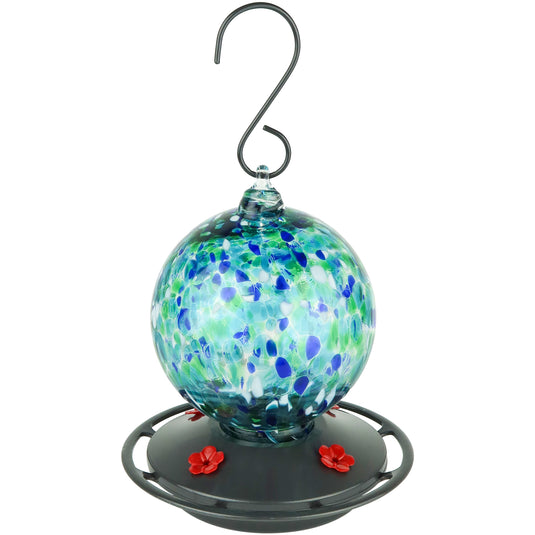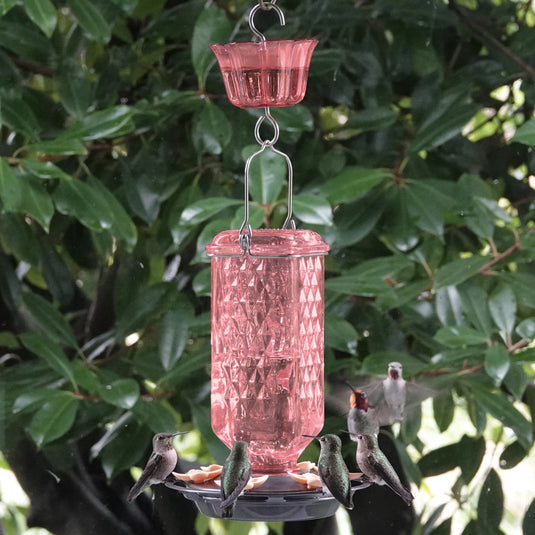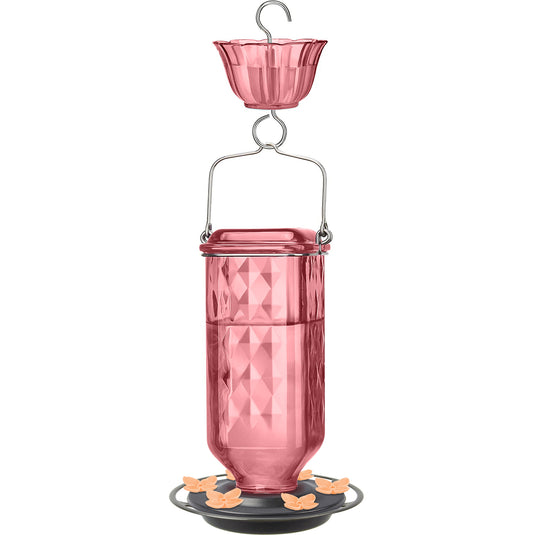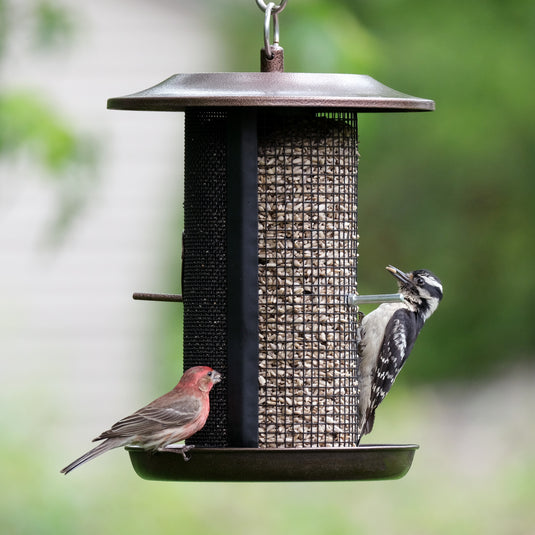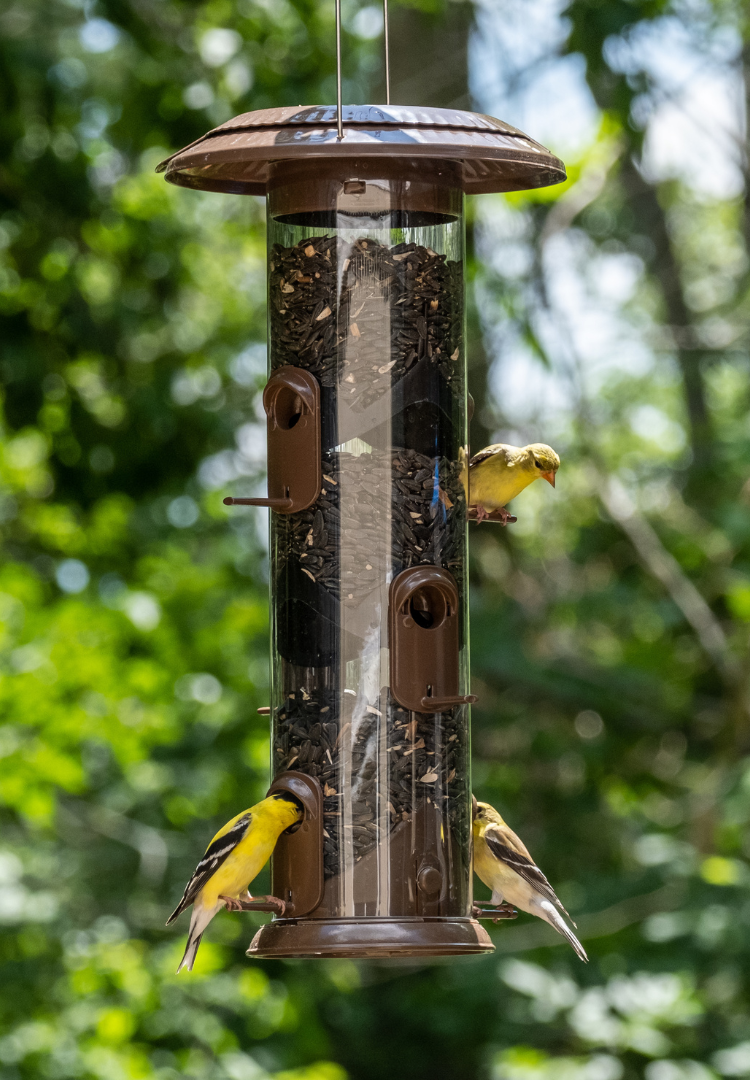With warmer weather upon us and nesting season (mostly) behind us, our summer birds are enjoying a few weeks of downtime before they start to prepare for fall migration. Now is the perfect time to spoil your backyard birds (and yourself) with a new feeder that provides maximum bird comfort and has features that make it easy to maintain!
In general, it’s best to look for bird feeders that have these features:
- Easy to clean
- Easy to fill
- Large and small bird spacing
- Attracts specific birds for your enjoyment
- Squirrel resistant (if squirrels are an issue in your yard)
- Bee and ant resistant (if feeding nectar)
Skip to section
Hummingbird feeders
Oriole bird feeders
Suet bird feeders
Squirrel proof bird feeders
Hopper bird feeders
Platform bird feeders
Tube bird feeders
Hummingbird feeders
Hummingbirds will come eagerly to feeders stocked with sugar water. Once found, they will learn to seek out this rich food even if the location or appearance of the feeder is changed. Although the most traditional color for hummingbird feeders is red, researchers have proven that hummingbirds are attracted to a variety of colors. So don’t let color be a factor in your decision other than your own personal preference!
If pests like bees and ants are a problem at your feeder in the summertime, look for a design with a dome-shaped base to help deter bees. This design helps prevent the bees from reaching the nectar while keeping sufficient space for the hummingbird’s tongue - did you know that a hummingbird’s tongue can stretch twice the length of its beak? Many hummingbird feeders have built-in ant moats, which trap ants in a small cup of water before they have the opportunity to reach the feeder. You may also choose a feeder without an ant moat and add a separate one later.
One of the most important features to look for in a hummingbird feeder is the ability to clean it thoroughly. It is inevitable that sugar water will eventually break down and cause mold, fungus, or other harmful bacteria to grow inside of a hummingbird feeder – especially in the summer heat! To prevent mold growth, hummingbird feeders need to be cleaned frequently - at least every 4-5 days. Since you’ll be cleaning it often, make sure that your hummingbird feeder has removable parts that are easy to clean. Some feeders are even dishwasher safe!
Another way to prevent mold growth is to make sure you only fill your feeders with nectar that your hummingbirds will drink within a couple of days. A small capacity feeder can help control the amount of nectar in your feeder at one time.
Still not sure which hummingbird feeder is best for you? Use our hummingbird feeder selector and answer a few quick questions to get personalized results just for you!
Oriole bird feeders
Feeding the orioles can be a summer treat! With one of the shortest migratory seasons, most orioles start returning south for the winter around August and September. Since their diet is composed mainly of nectar and ripe fruit, oriole feeders typically have dishes for jelly or nectar and spikes to feed fruit slices. When selecting an oriole feeder, look for one that has a protective baffle that shields the feeder and its contents from the weather to keep them fresher longer. Since the sweet offerings of an oriole feeder can attract unwanted pests, some oriole feeders have bee-resistant and ant-resistant features to keep them at bay.
Suet bird feeders
Suet might not be top of mind as a summer feed, but suet is actually an excellent source of energy for newly fledged birds! Here’s a tip: If you live in an area with hot temperatures, fill your suet feeders with a no-melt variety that has a higher melting point.
Squirrel proof bird feeders
Squirrels are an ever-present nuisance at bird feeders no matter the season. If you know that squirrels are a problem in your yard, choosing a bird feeder with squirrel-resistant features will help keep these feeder pests at bay. Look for a feeder with a locking roof, collapsible perches, or a seed shield that will make it harder for squirrels to reach the seed inside.
Remember, the most important squirrel proofing step you can take is proper feeder placement. If a squirrel is able to reach over from a nearby foothold and avoid placing any weight on the feeder, it may be able to access the bird seed. To overcome this problem, allow for at least 18 inches/47 cm of clearance around the feeder. This will force the squirrel to climb or jump onto the feeder and cause the perches to collapse under the weight.
Hopper bird feeders
Hopper bird feeders are a good choice for the summertime since they can accommodate a variety of small and large birds. Look for a hopper feeder that has a wide opening for easy filling and removeable parts for thorough cleaning. Since the summertime can bring unpredictable weather and rain, it’s important to make sure your feeder has a seed tray with good drainage to keep your bird seed fresh, even in the heat.
Platform bird feeders
Platform feeders are an excellent choice for any birder who wants to attract the widest variety of birds with virtually any type of seed. The open design of this feeder allows many birds of multiple sizes to feed at once, making for a busy and exciting experience! The most important features to look for in a platform feeder are good drainage and quality materials. Choose a platform feeder with hardware that won’t rust and materials that are resistant to rot and insects. A removeable tray with perforations for drainage will allow water to drain and air to flow while making it easy to keep clean.
Tube bird feeders
If you’re looking to feed medium and small sized birds, a tube feeder might be the right choice for you. To maximize your bird viewing, look for a tube feeder that has a lot of perches and even-feed baffles that keep a constant seed level at all seed ports. Feeders with a wide funneled opening and a large seed capacity will make for less frequent and easy fillings. For specifically feeding finches, you may choose a mesh feeder or replace the regular seed ports with thistle inserts, which come included with every Nature’s Way tube feeder.







